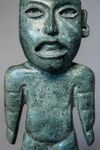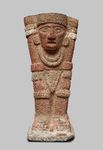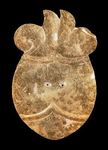The Aztecs - Weltmuseum Wien
←
→
Page content transcription
If your browser does not render page correctly, please read the page content below
The Aztecs 15 October 2020 to 13 April 2021 In 2020, the Weltmuseum Wien will present an exhibition on the legendary art and culture of the Aztecs (ca. 1430 - 1521 AD). This highlight exhibition focuses on tributes and sacrifices that played an important role in the Aztecs' economic and religious life. Particular attention is also paid to the Aztec capital Tenochtitlán, which served as a hub as well as the religious and cultural centre of the empire. The special exhibition „The Aztecs“ was conceived by the Linden-Museum Stuttgart in cooperation with the Nationaal Museum van Wereldculturen in the Netherlands. It took place at Stuttgart in 2019 for the 500th anniversary of the conquistador Hernán Cortés' landing off the coast of Mexico. The Aztecs dominated a large part of Mesoamerica at the time of the Spanish conquest in the early 16th century. As a nomadic people, the Aztecs finally settled on several small islands in Lake Texcoco, where they founded the city of Tenochtitlán, present-day Mexico City, in 1325. In the 15th century, they created an empire surpassed in the Americas only by the Incas in Peru. The Aztecs are among the most well-documented of all Indian civilizations in the 16th century. Visitors retrace Cortés footsteps: starting with the periphery of the Aztec empire and the cultural diversity of Mexico, the exhibition leads to the sacred precinct of the capital Tenochtitlán. The exhibition features more than 200 objects and items on loan from Mexican and European museums, including the Museo del Templo Mayor and the Museo Nacional de Antropología in Mexico City. The world-famous feather headdress exhibited in the permanent exhibition will - among other objects from the Weltmuseum Wien collection - supplement the special exhibition „The Aztecs“. As part of a collaboration between Mexico and Austria, the last existing Aztec feather headdress has now been comprehensively cleaned and conserved. Thanks to this measure, the iridescent splendour of the feathers' green and blue tones and over 1500 gold leaves once again come into their own. CATALOGUE The exhibition catalogue will be published in German and Englisch. 360 pages, 21,5x27,5 cm, Hardcover € 30,-
PRESS PHOTOGRAPHS Press photographs are available in the press section of our website free of charge, for your topical reporting: https://www.weltmuseumwien.at/presse/ Quetzal-feather headdress Feathers of the quetzal, cotinga, roseate spoonbill, squirrel cuckoo, kingfisher; wood, reed chips, fibres, paper, cotton, leather, gold, brass H: 130 cm, W: 178 cm Mexico, Aztec, around 1520 AD KHM-Museumsverband, Weltmuseum Wien, Inv. no. 10.402 © KHM-Museumsverband Mictlantecuhtli Ceramic, pigment H: 176 cm; W: 80 cm; D: 50 cm Mexico, Aztec, Late Period, between 1430 and 1502; found in the “House of Eagles” as one of two almost identical sculptures Museo del Templo Mayor, Mexico City, D.R. Secretaría de Cultura – INAH, Inv. no. 10-264984 © D.R. Archivo Digital de las Colecciones del Museo Nacional de Antropología, Secretaría de Cultura – INAH Brazier, water and fertility goddess Chalchiuhtlicue Ceramic, pigment H: 55.2 cm; W: 64.3 cm; D: 49.4 cm Central Mexico, Aztec, late period, early 16th century; discovered near the sacred district of Tlatelolco Museo Nacional de Antropología, Mexico City, D.R. Secretaría de Cultura – INAH, Inv. no. 10-1125 © D.R. Archivo Digital de las Colecciones del Museo Nacional de Antropología, Secretaría de Cultura – INAH
Greenstone figurine with calendar signs Serpentine H: 34 cm; W: 17.5 cm; D: 7 cm Mexico, Teotihuacan, 250 –750 A.D., re-worked by Aztec artists Museum am Rothenbaum Hamburg, Inv. no. FSB 264 © Museum am Rothenbaum Hamburg, Foto: Paul Schimweg Greenstone figurine with calendar signs Serpentine H: 34 cm; W: 17.5 cm; D: 7 cm Mexico, Teotihuacan, 250 –750 A.D., re-worked by Aztec artists Museum am Rothenbaum Hamburg, Inv. no. FSB 264 © Museum am Rothenbaum Hamburg, Foto: Paul Schimweg Bird head mask Wood, turquoise, spondylus shell, resin, mother-of- pearl, malachite L: 29 cm; W: 15.5 cm; H: 13.5 cm Mexico, Aztec, between ca. 1350 and 1521 AD Stiftung Schloss Friedenstein Gotha. Inv. no. Eth7R © Stiftung Schloss Friedenstein Gotha Skull mask Human skull, flint, sea shell, pyrite H: 19 cm; D: 13 cm Mexico, Aztec, 15th century; discovered within the Templo Mayor, ofrenda no. 11 Museo del Templo Mayor, Mexico City, D.R. Secretaría de Cultura – INAH, Inv. no. 10-162934 © Gliserio Castañeda, D.R. Secretaría de Cultura – INAH
Eagle’s head Stone H: ca. 100 cm; W: ca. 120 cm Mexico, from the area of Tehuacán, Puebla, Mexico; Aztec, between ca. 1350 and 1521 AD; Discovered at the foot of a mountain Royal Museum of Art and History, Brussels, Inv. no. AAM 69.11 © Royal Museum of Arts and History, Brüssel Staff or statue attachment Wood, turquoise, spondylus shell, resin, mother-of- pearl, malachite H: 29 cm; W: 12 cm; D: 17 cm Mexico, Aztec, between ca. 1350 and 1521 AD National Museum of Denmark, Copenhagen, Inv. no. ODIh.41 © National Museum of Denmark, Roberto Fortune Stamp, monkey Ceramic H: 5.3 cm; W: 4.5 cm; D: 3.5 cm Mexico, Aztec, between ca. 1350 and 1521 AD Collection Nationaal Museum van Wereldculturen Coll. no. RV-2971-57; © Collection Nationaal Museum van Wereldculturen Coll.no. RV-2971-57 Pulque beaker Phyllite H: 37 cm; D: 18 cm; D: 26 cm Mexico, Aztec, beginning of the 16th century KHM-Museumsverband, Weltmuseum Wien, Inv. no. 6.069 © KHM-Museumsverband
Carrier figure Volcanic stone, pigment H: 78.5 cm; B: 34.5 cm; D: 26 cm Mexico, Tlaxcala, 1000–1500 AD KHM-Museumsverband, Weltmuseum Wien, Inv. no. 59.144 © KHM-Museumsverband Cuauhxicalli (Eagle Bowl), sacrificial bowl Stone H: 6.5 cm; D: 16 cm Mexico, Aztec, around 1500 AD KHM-Museumsverband, Weltmuseum Wien, Inv. no. 59.896 © KHM-Museumsverband Jewel in the shape of a heart Gold H: 4.1 cm; W: 2.6 cm; D: 0.1 cm Mexico, Aztec, Late Period, early 16th century; discovered within an ofrenda at the Templo Mayor Museo del Templo Mayor, Mexico City, D.R. Secretaría de Cultura – INAH, Inv. no. 10-654079 © Jorge Pérez de Lara, D.R. Secretaría de Cultura – INAH
Coyote or young wolf Basalt H: 39.8 cm; B: 21 cm; T: 23.3 cm Mexico, Aztec, between ca. 1350 and 1521 AD Museo Nacional de Antropología, Mexico City, D.R. Secretaría de Cultura – INAH, Inv. no. 10 47 © D.R. Archivo Digital de las Colecciones del Museo Nacional de Antropología, Secretaría de Cultura – INAH Sculpture in the shape of a snake Stone H: 34 cm; W: 23 cm; D: 30 cm Mexico, Aztec, between ca. 1350 and 1521 AD Museum am Rothenbaum Hamburg, Inv. no. B3637 © Museum am Rothenbaum Hamburg, Foto: Paul Schimweg
OPENING HOURS MUSEUM & CAFÉ Daily except Wednesday 10 a.m. to 6 p.m. TICKETS www.weltmuseumwien.at/en/information/#tickets CONTACTS FOR YOUR VISIT Museum education & outreach programme, guided tours, and programme registration +43 1 534 30-5150 kulturvermittlung@weltmuseumwien.at Information, questions & suggestions +43 1 534 30-5052 info@weltmuseumwien.at SOCIAL MEDIA Follow the Weltmuseum Wien on Facebook and Instagram. JOURNALIST ACCREDITATION Journalists visiting the KHM-Museumsverband for professional purposes are entitled to free admission to its exhibitions and locations. For this purpose, you need to register via info.pr@weltmuseumwien.at at least two working days in advance. We request that, in addition to mentioning your medium, you also specify the date of your visit and attach a scan of your valid press pass. Many thanks for your understanding! PRESS CONTACT Nina Auinger-Sutterlüty, MAS Mag. Sarah Aistleitner KHM-Museumsverband T +43 1 525 24 -4021 /-4025 info.pr@weltmuseumwien.at
You can also read



























































